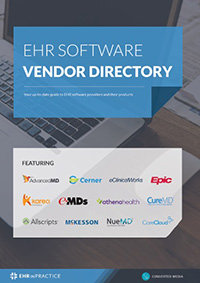What are the core functions of EHR
Over the last two decades, EHR technology has developed to include an array of functions that surpass the essential functions that the early crop of EHR products on the market possessed. The improvements in functionality have been driven by a combination of advances in technology and by consumers demands for more sophisticated features that improve efficiency and quality of care. Despite the introduction of more advanced features, an effective EHR product still have a robust set of core features that serve as the backbone for other more ancillary features.
In the present EHR market, the products at their core will possess a minimum set of features that are required to meet ONC certification. Therefore, it is not a question of whether this core functionality is present; instead, it is more a matter of how well these core functions perform in an EHR product.
What are the core functions of EHR, and what is their purpose?
In 2003, as the adoption of EHR technology became more commonplace, the Department of Health and Human Services commissioned the Institute of Medicine Committee on Data Standards for Patient Safety (IOM) to conduct a study and prepare a report defining a functional model of the key capabilities for an EHR system. According to the report, entitled “Key Capabilities of an Electronic Health Record System,” its purpose was to provide a “functional model of an EHR system to assist providers in acquiring and vendors in developing software.” In the report, IOM outlined eight core functions an EHR should be capable of performing to achieve the overriding goals of improving quality care, chronic disease management, efficiency, and feasibility. These functions included:
These functions include:
- health information and data
- result management
- order management
- decision support
- electronic communication and connectivity
- patient support
- administrative processes and reporting
- reporting and population health
In addition to the eight core functions set forth by the IOM, one should also consider the requirements established by CMS’s EHR Incentive Programs to the Promoting Interoperability Programs (formerly the Meaningful Use Program). The core functions outlined in this program focus on interoperability and improving patient access to health information. In summary, the core functions contained in Stage 3 include functions that improve:
- Coordination of Care through Patient Engagement
- Health Information Exchange
- Public Health Reporting.
- Collecting and Reporting on Quality of Care Measures
Check out our ultimate EHR features guide to find all the functionality your system should include
When taken in addition to the core functions established by the IOM, one can arrive at an updated list of core EHR functions that an EHR should display
Health information and data
An EHR’s core purpose rests on collecting clinical data regarding patients' diagnoses, allergies, lab test results, and medications. It must also be able to process and store these data in a way that can be easily retrieved, analyzed, and transmitted.
Result management
To effectively allow clinicians to provide quality care an EHR should allow all providers participating in the care of a patient in different settings to quickly access new and past test results in the EHR system. Under the Incentive Programs to the Promoting Interoperability Programs requirements, this function would include the ability to share results with other providers and the patient in order coordinate care and engage the patient in his or her care.
Order management
As a further measure to enhance care coordination and to ensure patient safety as care is provided across multiple settings, an EHR should allow clinicians to enter and store orders for prescriptions, tests, and other services to enhance legibility, reduce duplication, and improve the speed with which orders are executed.
Decision support
Using notifications and decision-support systems would help improve compliance with best clinical practices, ensure regular screenings, and other preventive practices. Decision support not only serves as a tool to enhance clinical decision making it also acts to improve patient population health by ensuring patients are reminded to take advantage of preventative care to mitigate the risk of chronic disease and to comply with existing treatment plans.
Electronic communication and connectivity
Under Incentive Programs to the Promoting Interoperability Programs, care coordination, and patient engagement through enhanced messaging systems provides the ability to send and access secure communications among providers and patients.
Patient support
Patient support tools allow patients the ability to access to their health records, offer to provide patient education material, and assist providers in home-monitoring for patients with chronic conditions and allow patients to conduct self-testing to improve the self-management chronic conditions.
Administrative processes and reporting
Administrative processes and reporting tools refer to features such as scheduling systems, to improve efficiency and provide more timely services to patients. Practice management features that automate many of the day-to-day administrative work conducted in healthcare, such as billing, patient outreach, scheduling, and time management are included.
Reporting and population health
To improve community health, an EHR should be able to store and transmit clinical data to provide public health entities with information regarding patient safety and disease surveillance. Reporting and population health functionality should also provide a practice the ability to submit immunization data and receive immunization forecasts and histories from the public health immunization registry/immunization information system (IIS) and submit syndromic surveillance data from a non-urgent care ambulatory setting for EPs.
Check out our EHR requirements gathering guide to make sure your system selection is on track
Interoperability
Interoperability refers to the ability of two or more EHR systems or components of an EHR system to exchange information and to use the information that has been exchanged. Interoperability not only involves the way data is structured to allow it to be shared; it also refers to the system’s ability to share this data. Policymakers view the interoperability as the foundation on which the modernization of the US healthcare system rests upon, as such EHRs should be interoperable.
Collecting and reporting on the quality of care measures
Being able to collect, analyze and report data regarding quality of care is an important function under Incentive Programs to the Promoting Interoperability Programs. An EHR should be able to allow practices the ability to comply with quality-based reimbursement programs, but also allows them to examine data related to their quality of care and to make changes if needed.
The IOM report on the core functions of an EHR largely remain relevant today and have been expanded upon by other efforts to encourage more sophisticated EHR use by providers. Understanding the core functions of an EHR offers selection teams the ability to better understand how an EHR’s features can assist in meeting overall goals related to efficiency and quality of care.
Free white paper

50 features to look for in your next EHR
A comprehensive guide to EHR features and how they can benefit your practice

Featured white papers
-

50 features to look for in your next EHR
A comprehensive guide to EHR features and how they can benefit your practice
Download -

EHR Vendor Directory
Get the most up-to-date directory of EHR software vendors. Find the best software for your practice.
Download -

EHR Pricing Guide
Get your complete guide to EHR software pricing and project costs. Your headstart on EHR pricing research
Download
Related articles
-

EHR requirements and key features: your complete guide
Our extended guide to EHR requirements - everything you need to know and more on the subject
-

The most important EHR features for practice management
The key functionalities any practice management software should have
-

Cloud EHR: a complete buyers' guide
Thinking about a cloud EHR for your practice? Read our comprehensive guide first.

